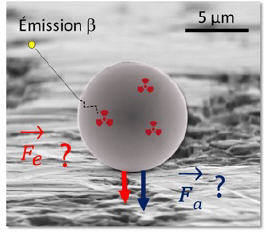Team
- Permanent member: Olivier Pluchery
- Past PhD: Samuel Peillon (26 Oct 2020). Influence of electrostatic effects linked to radioactivity on adhesion forces and on the suspension of metallic particles
Adhesion of nanoparticles and dust on surfaces is an intricate combination of Van der Waals forces, surface roughness, and electrostatic forces. By using an AFM, we are able to measure adhesion forces of spherical nano- and micro-particles. This fundamental understanding of fundamental interaction is crucial for how metallic dusts or pollutants are released in the atmosphere.

Figure: A tungsten particle with a radius of 3 µm and charged with tritium is deposited on a tungsten surface. The tritium radiation will induce an electric charge in the particle, modifying its adhesion forces (PhD thesis of Samuel Peillon, 2020).
Collaborations
- C. Grisolia (CEA)
- F. Gensdarmes (IRSN)
Publications
- S. Peillon, G. Dougniaux, M. Payet, E. Bernard, G. Pieters, et al.. Dust sampling in WEST and tritium retention in tokamak-relevant tungsten particles. Nuclear Materials and Energy, Elsevier, 2020, 24, pp.100781. ⟨10.1016/j.nme.2020.100781⟩. ⟨hal-02969014⟩
- Samuel Peillon, Adrien Autricque, Michaël Redolfi, Cristian Stancu, François Gensdarmes, et al.. Adhesion of tungsten particles on rough tungsten surfaces using Atomic Force Microscopy. Journal of Aerosol Science, Elsevier, 2019, 137, pp.105431. ⟨10.1016/j.jaerosci.2019.105431⟩. ⟨hal-02322543⟩
- A. Autricque, S. Peillon, F. Gensdarmes, Moustapha Sow, N. Fedorczak, et al.. Dust remobilization from rough planar surfaces in tokamak steady-state plasmas. Nuclear Materials and Energy, Elsevier, 2018, 17 (Décembre 2018), pp.284-288. ⟨10.1016/j.nme.2018.11.013⟩. ⟨hal-01978595⟩

